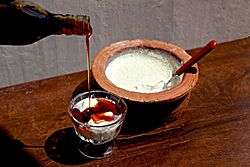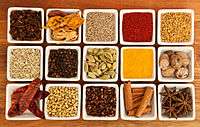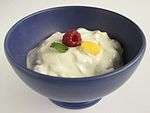Dahi (curd)
Dahi is a traditional yogurt or fermented milk product, originating from the Indian subcontinent, usually prepared from cow's milk, and sometimes buffalo milk, or goat milk.[1] It is popular throughout the Indian subcontinent.[1] The word curd is used in English to refer to (naturally probiotic) homemade yogurt,[2][3] while the term yogurt refers to the pasteurized commercial variety known as heat treated fermented milk.[4]
Curd in a traditional Manipuri earthen pot | |
| Alternative names | Curd, doi, perugu, thayir |
|---|---|
| Course | Homemade yogurt/Fermented milk product |
| Place of origin | Indian subcontinent |
| Associated national cuisine | Bangladesh, India, Nepal, Pakistan, Sri Lanka |
| Main ingredients | Cow's milk, buffalo milk, or goat milk; Lactobacillus |
| Variations | Mishti doi, Nabadwip-er lal doi |

Preparation
Dahi is made by bacterial fermentation of milk. In this process lactose in milk is converted into lactic acid by several probiotic microorganisms. The species involved in the fermentation depends on the temperature and humidity of the environment, and may include Lactococcus lactis, Streptococcus diacetylactis, Streptococcus cremoris, Lactobacillus delbrueckii subsp. bulgaricus and Streptococcus thermophilus.
Dahi starter is sometimes made with dried red chillies (or their stems) in hot milk. Milk is boiled and then allowed to cool for a while. When lukewarm, dried chili peppers or their stems are added. The reason for this tradition is that dried chillies are rich in a type of lactobacilli, the bacteria that helps in fermentation of milk to form dahi. The bowl is then kept undisturbed in a warm place for 5 to 10 hours.
After the starter is made, or saved from previous batch of dahi, milk is boiled and cooled. In a separate bowl dahi is mixed with its whey, and then mixed together with the milk. It is then left to sit undisturbed for 5 to 10 hours.
This practice can also be applied for making dahi/yogurt from milk substitutes, such as soy milk.[5]
Types
Buffalo curd

Buffalo curd (Sinhala: මුදවාපු මී කිරි mudavāpu meekiri) is a traditional type of yogurt prepared from water buffalo milk. It is popular throughout the Indian subcontinent. Buffalo milk is traditionally considered better for making yogurt than cow milk due to its higher fat content making a thicker yogurt mass.[6] Buffalo curd is usually packaged in clay pots.
Buffalo curd is obtained by bacterial fermentation of buffalo milk. In this process lactose in buffalo milk is converted into lactic acid using several micro-organisms. The species involved in the fermentation are the same as above.
Buffalo milk has a higher amounts of protein, fat, lactose, minerals and vitamins than cow's milk. Quality of the curd depends on the starter culture. Fermentation also develops the characteristic flavor and colour of the product.
Buffalo curd can be made in both traditional and industrial forms. Traditionally buffalo milk is filtered and boiled, the scum is removed and it is cooled to room temperature. A few spoonfuls of a previous batch of curd are added and it is then mixed well and poured into clay pots. These are sealed by wrapping a piece of paper over the pot and allowing it to stand for 12 hours.[7]
Dahi dishes

Curd is an important part of everyday diet in the Indian subcontinent, both in slow cooked food and fast food.
- Slow (cooked) food
- Dahi chawal – curd rice
- Dahi kadhi – curd curry
- Doi maach – fish in curd curry, Bengali dish
- Coconut chutney – side dish for Idli/Dosa/Uttapam, south Indian cuisine
- Raita / Borhani – side dish for biryani
- Dahi baigan/Kathrikai thayir kothsu – Eggplant with curd, south Indian cuisine
- Perugu Pachadi – curd-based dip, Andhra dish
- Thepla – served with plain curd, Gujrati dish
- Fast food
- Dahi vada / Dahi bhalla[8] – Vada soaked in curd
- Lassi – curd mixed with water and sweetener, usually sugar or molasses.
- Chaas - curd mixed with water and Sea salt, black salt or Himalayan salt. It is also known as buttermilk.
- Borhani - curd mixed with coriander and mint, Bangladeshi drink
- Papri chaat
- Dahi puri – variation of Panipuri, using curd instead of tamarind water
- Dahi bhelpuri – variation of bhelpuri, with curd on top
- Aloo tikki – plain curd is a side dish for aloo tikki
- Aloo paratha – plain curd is a side dish for aloo paratha
- Mishti doi – curd that is fermented after adding sweetener to milk, usually cane jaggery or date palm jaggery, a Bengali dessert.
See also
 |
| This article is part of the series on |
| Indian cuisine |
|---|
|
Regional cuisines
|
|
Ingredients, types of food
|
|
See also
|
|
Related cuisines |
|
References
- Caballero, B.; Finglas, P.; Toldra, F. (2015). Encyclopedia of Food and Health. Elsevier Science. pp. 345–351. ISBN 978-0-12-384953-3. Retrieved December 6, 2017.
- The curious case of the Indian curd -Hindustan Times
- Making yogurt -blog
- Codex Alimentarius Yogurt rules, FAO
- The secret of making soy yogurt without store bought culture
- Kristbergsson, Kristberg; Oliveira, Jorge. Traditional Foods: General and Consumer Aspects.
- "Curd and Treacle". Lanka Newspapers. 2008-10-18. Archived from the original on 2013-09-05. Retrieved 2009-08-31.
- Vohra, A.R. (2012). New Modern Cookery Book. V&S Publishers. p. 104. ISBN 978-93-5057-278-8. Retrieved December 6, 2017.
